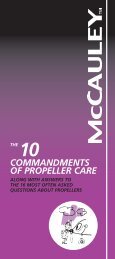propeller performance - McCauley Propeller Systems - Textron
propeller performance - McCauley Propeller Systems - Textron
propeller performance - McCauley Propeller Systems - Textron
Create successful ePaper yourself
Turn your PDF publications into a flip-book with our unique Google optimized e-Paper software.
10<br />
8. What are the effects of<br />
engine horsepower and<br />
RPM on the <strong>propeller</strong>,<br />
and vice versa?<br />
I could take all day on that one, but the<br />
strudel’s getting cold-so briefly, here it is. For<br />
fixed pitch <strong>propeller</strong>s, assuming a fixed<br />
throttle setting, the <strong>propeller</strong> (and engine)<br />
RPM will change as the airspeed changes.<br />
With a constant airspeed, the fixed pitch<br />
<strong>propeller</strong> (and engine) RPM will change if<br />
power is increased or decreased. The<br />
constant speed <strong>propeller</strong> employs an engine<br />
governor to automatically provide constant<br />
RPM at whatever throttle setting the pilot<br />
selects. The blade angle is changed<br />
automatically and increases or decreases if<br />
RPM setting is decreased or increased, or if<br />
power is increased or decreased. With fixed<br />
RPM and power setting, the blade angle will<br />
change automatically as airspeed increases or<br />
decreases. The RPM range is determined by a<br />
<strong>propeller</strong> control in the cockpit which may be<br />
adjusted to any setting between high and<br />
low. Most governors are designed to return<br />
automatically to high RPM setting.



